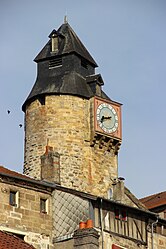Bar le Duc
| Bar-le-Duc | ||
|---|---|---|
| Prefecture and commune | ||

Clock tower
|
||
|
||
| Coordinates: 48°46′19″N 5°09′37″E / 48.7719°N 05.1603°ECoordinates: 48°46′19″N 5°09′37″E / 48.7719°N 05.1603°E | ||
| Country | France | |
| Region | Grand Est | |
| Department | Meuse | |
| Arrondissement | Bar-le-Duc | |
| Canton | Bar-le-Duc-1 and 2 | |
| Intercommunality | Bar-le-Duc | |
| Government | ||
| • Mayor (2014–2020) | Bertrand Pancher (UMP) | |
| Area1 | 23.62 km2 (9.12 sq mi) | |
| Population (2009)2 | 15,895 | |
| • Density | 670/km2 (1,700/sq mi) | |
| Time zone | CET (UTC+1) | |
| • Summer (DST) | CEST (UTC+2) | |
| INSEE/Postal code | 55029 /55000 | |
| Elevation | 175–327 m (574–1,073 ft) (avg. 240 m or 790 ft) |
|
|
1 French Land Register data, which excludes lakes, ponds, glaciers > 1 km² (0.386 sq mi or 247 acres) and river estuaries. 2Population without double counting: residents of multiple communes (e.g., students and military personnel) only counted once. |
||
1 French Land Register data, which excludes lakes, ponds, glaciers > 1 km² (0.386 sq mi or 247 acres) and river estuaries.
Bar-le-Duc (French pronunciation: [baʁ lə dyk]), formerly known as Bar, is a commune in the Meuse département, of which it is the capital. The department is in Grand Est in northeastern France.
The lower, more modern and busier part of the town extends along a narrow valley, shut in by wooded or vine-clad hills, and is traversed throughout its length by the Ornain, which is crossed by several bridges. It is limited towards the north-east by the Marne-Rhine Canal, on the south-west by a small arm of the Ornain, called the Canal des Usines, on the left bank of which the upper town (Ville Haute) is situated.
Bar-le-Duc was at one time the seat of the countship, later Duchy of Bar. Though probably of ancient origin, the town was unimportant until the 10th century when it became the residence of the counts. Originally part of the early medieval duchy of Upper Lorraine, at some stage in the early modern period it was acquired by the neighbouring dukes of Lorraine.
The Ville Haute, which is reached by staircases and steep narrow thoroughfares, is intersected by a long, quiet street, bordered by houses of the 15th, 16th and 17th centuries. In this quarter are the remains (16th-century) of the château of the dukes of Bar, dismantled in 1670, the old clock-tower, and the college, built in the latter half of the 16th century. Its church of Saint-Étienne (constructed during the 14th and 15th centuries) contains a skillfully carved effigy in white stone of a half-decayed corpse, erected to the memory of René of Châlon (died 1544), the work of 16th-century artist Ligier Richier, a pupil of Michelangelo.
...
Wikipedia



